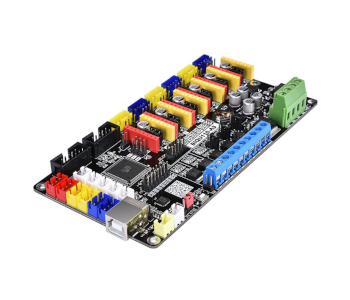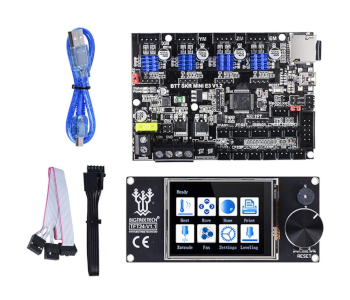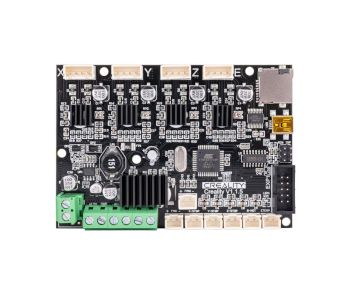3d Printer Controller Board With With Firmware
3D Insider is advertisement supported and earns money from clicks, commissions from sales, and other ways.
The simplicity and user-friendliness of modern 3D printers confute just how much engineering science lies nether the hood. 3D printers have a huge number of motors, sensors, and heating elements that work together to attain the machine’s purpose. However, the central “brain” that directs all these components is a 3D printer’s controller board.
If you bought a fully assembled desktop 3D printer, so picking a controller lath is probably something yous won’t demand to carp with. This guide is made for those who are into assembling their own
DIY 3D printers.
What are 3D printer controller boards?
Controller boards are compact printed circuit boards (PCBs) that handle all the logic functions and requirements of a 3D printer. Information technology receives the g-code commands from the
slicer software
and converts them to commands to the various components of the printer including the motors and heating elements. The controller board also receives data from the printer’s sensors, running them through a built-in algorithm to come upward with the appropriate response.
Older 3D printers typically had bones controller boards designed to handle merely the central functions needed in 3D press. However, controller boards have evolved in the concluding couple of years to adjust features such as Wi-Fi access, shorter response times, more complex algorithms, and more powerful motors.
What to look for in a 3D printer controller board
Despite the prevalence of fully assembled 3D printers, there is even so a huge market out there for controller boards for those who want to get together custom-congenital 3D printers. With and then many brands and models out there, picking one with the right specs can be an overwhelming task. To aid y’all choose the controller board that is just right for your needs, here are some factors to consider:
Firmware compatibility
Every controller board comes with a built-in firmware. The important affair for y’all to check is if this firmware is compatible with your 3D printer and its components. For instance, some
Arduino controller boards
are designed solely for specific 3D printer models. More than generic ones, like RAMPS or RAMBo, have wider compatibility lists.
Wider compatibility isn’t always ideal, considering a more than specialized controller lath typically makes better use of a 3D printer’s more complex features. Our communication is to remember of a build that yous’re going for and wait for components that are compatible with it.
Processor ability
8-fleck boards are very mutual in older 3D printers, but you lot tin become controller boards right at present that are 32-bit. Theoretically, 32-chip boards are capable of processing more calculations per minute than 8-fleck boards and should help reduce the press time for any given projection. This doesn’t always translate well to actual performance as there are several other bottlenecks along the process, such as the USB connection or the movement of the stepper motors.
In any example, getting a 32-bit lath versus an viii-bit lath is considered a skillful move in that your build is more than future-proof. For the DIY enthusiast, the ability to upgrade with better components is always considered a good thing.
Wired or wireless advice
Wired communication with the controller lath isn’t much of a problem nowadays. Merely nearly all controller boards offer a plethora of wired communication ports including the archetype USB Blazon-A, the newer USB Type-C, mini-USB, and micro-USB.
Again, nosotros prefer coming upwards with a future-proof build. This ways outfitting your 3D printer with wireless communication options. Wi-Fi capabilities would be ideal, admitting they can make a controller board quite expensive. Y’all can salve a few dollars by looking for a board with an Ethernet port. Either way, you will proceeds the power to control or monitor your 3D printer remotely.
Stepper drivers
A stepper driver is essentially the circuit that controls the operation of stepper motors. They work by sending controlled pulses of current to stepper motors so that they run in the desired increments. The stepper motors, in plough, handle high-precision movements in the 3D printer such every bit the rotation of the
extruder
gears and the motion of the nozzle along the print bed. The stepper driver is a particularly crucial function of the controller board as they tend to oestrus upwards and get worn downward rather quickly.
There are two options when choosing a stepper driver assembly – it can either be built-in to the lath or be plugged in separately. Congenital-in stepper drivers typically accept better heat dissipation, which makes them last longer. However, they can too be a pain to supersede. In dissimilarity, plug-in drivers are easier to supersede just have the disadvantage of smaller heatsinks.
Microstepping operation
Microstepping is the process by which controller boards can separate up the movement of stepper motors to even smaller intervals. While this may enhance the resolution of a printer, whatever 3D printer is yet limited by other factors such as nozzle bore.
The biggest do good of better microstepping lies in reduced vibrations in the movement of the component existence driven by a stepper motor. This means amend electrical efficiency and less noise.
The benefits of better microstepping may seem subtle, merely they are often enough to justify choosing one lath over the other. Most controller boards are capable of 1/16th microstepping, merely other boards tin can go every bit minor as 1/128 or ane/256. However, you lot will notwithstanding need to accept the correct stepper commuter and stepper motor to realize the benefits of improve microstepping.
Top 5 all-time 3D printer controller boards
1.
BIGTREETECH TFT35 V3.0 Smart Display 3D Printer Controller Board

This controller board from BIGTREETECH is i of the most popular upgrade options, especially for those who run Ender three Pro 3D printers. Its main feature, of class, is the integrated touchscreen display. This touchscreen interface provides easier access to tuning, calibration, and other more than avant-garde features. However, the classic rotary knob is even so at that place for more old-fashioned users.
This controller board comes with a 32-bit 120MHz ARM Cortex-M3 processor. It has no built-in Wi-Fi capability but has a reserved port for an external Wi-Fi module. If you don’t have the equipment to connect to the lath wirelessly, you can simply impress models on the lath using an SD bill of fare. The controller board has two sets of UART extension ports for components that y’all would similar to add together to your 3D printer such equally a filament run-out sensor.
One matter to take note of about the BIGTREETECH controller board is that information technology’south not exactly user-friendly. Poor documentation means that setting upward the board is not easy and that the lath isn’t designed to exist plug-and-play. Its born firmware is non open source, which somewhat detracts from its DIY objective. It’s non a terribly expensive lath, just the addition of a touchscreen ways that at that place are dozens of cheaper boards out there.
2.
BIQU Upgraded Rumba Controller Board

The Tango command board from BIQU is one of the about versatile controller boards in the market. Not just does it back up a broad range of 3D printers, only it’s too compatible with multicolor 3D printing. Best of all, it’s remarkably inexpensive.
This controller board comes with an ATMEGA2560 processor, 6 stepper motor interfaces, five temperature sensor interfaces, an expansion port for an LCD screen, half dozen-way pulse width modulation (PWM), and compatibility with all RAMPS-related firmware.
The all-time thing about this board is its versatility. It’s basically a RUMBA board with a lot of extra connectors, leaving room for more servo motors and stepper drivers. The Marlin firmware works well, has simple updates, and is quite easy to apply.
At less than $xxx, the BIQU controller lath is hard to beat out in terms of value for money. Some users have run into alignment problems when connecting the pins of their drivers. The board is likewise a piddling bigger than the standard RUMBA board, so yous might demand to bank check if you have infinite on your 3D printer’south controller board mount.
3.
BIGTREETECH SKR Mini E3 V1.2 Command Lath

Another entry from BIGTREETECH, this control board is a “stripped downwardly” version of the V3.0 control board with an integrated touchscreen. Instead, this controller board is a flake more than onetime-fashioned, opting instead for display supports instead of an integrated display.
The Mini E3 control board still has the ARM Cortex-M3 32-Scrap 72 MHz processor, Marlin ii.0 firmware, and optimized heat dissipation. The board was designed as an upgrade for the Ender-5 and Ender-3 series of 3D printers, thus information technology has the exact form factor of stock Creality boards. This means that swapping this board with your existing one should exist quick and like shooting fish in a barrel. So far, no alignment bug have been reported.
The 5.12 board comes with silent stepper motor drivers, which should result in much quieter 3D printer operations. Compared to stock boards, the SKR Mini E3 is said to have five times faster processing speeds and more than twice the original flash retention. Take note that you’ll also demand to update the firmware of your 3D printer to get this control board to work. All firmware updates are available via Bigtreetch’s GitHub page.
4.
Creality 3D Motherboard Silent Mainboard V1.15

The silent motherboard V1.15 from Creality is designed for a wider host of 3D printers – the Ender iii, Ender three Pro, Ender v, and CR-x. As its name implies, the Creality Silent Mainboard is made to help the 3D printer produce minimal dissonance. That said, don’t await this board to make your stepper motors completely silent.
Being a straightforward board replacement, installing the Silent Mainboard is much easier than near other 3D printer controller board. The board comes with pre-installed firmware for Ender 3 and Ender three Pro. For those who want to use this board with the Ender 5 Pro or CR-10, the firmware will have to exist installed by SD card. If you are unsure how to practise a board bandy, the best backup would exist to take pictures of your printer’s current board.
Despite the ease of installation, the experience of customers who used this board are mixed. Users have reported a variety of bug from slow heating, poor resolution prints, and inaccurate temperature measurements. These bug likely stem from improper installation or setup, which means that using the Creality Silent Mainboard may non exist as simple every bit the manufacturers imply.
5.
Entweg GT2560 3D Printer Controller Board

Rounding upward this listing is the GT2560 controller board from Entweg, which was designed as a replacement for the Arduino Mega2560 and RAMPS i.4 kit for Ultimaker 3D printers. This lath has the same Mega2560 processor but features a more meaty form gene, better heat dissipation, and more stable connectors for peripheral components.
The board comes with support for an LCD screen plus a retentiveness card interface, allowing for the loading of 3D models even without a PC. Moreover, the lath provides the choice to run at 24V instead of simply 12V, making it possible to run motors at higher rotation rates and college torque. Theoretically, this should speed up the printing process although you will demand to sentry out for added vibration and its effects on print quality.
Overall, this is a well-designed command board that manages to fit all essential ports of the Arduino Mega2560 in a smaller form factor. It’due south far from existence the cheapest control board for 3D printers but seems worth the price for the powerful processor and improved reliability.
Final thoughts
Backside all the sophisticated features and well-coordinated movements of a 3D printer is a figurer that processes all the 1000-code commands and information from the sensors. Through a series of logic control, the controller board of a 3D printer commands the heating elements to rut up to specific temperatures and the motors to rotate at fix speeds.
Given the purpose of a controller board, it comes every bit no surprise how there’s a huge market place for these boards that appeal to DIY 3D printer users. Fifty-fifty if y’all run a fully assembled 3D printer, there are probably upgraded controller boards out in that location that you can swap for your stock control board.
This can be a rather complex performance. if yous’re interested in swapping out your command board, y’all will want to read up on how to install new firmware on your 3D printer and how to configure new circuits for peripheral components.
3D printers should never be left unattended. They can pose a firesafety adventure.

